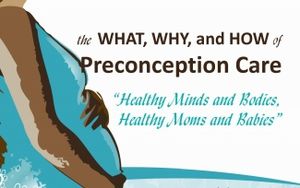Preconceptual Care
Introduction:[edit | edit source]
Preconception health is a woman health before being pregnant[1][2].It is a good opportunity for you and your partner to improve your health and identify any health conditions or risk factors that may affect you or your unborn baby before pregnancy.A healthcare professional can help you to assess your health, fitness and lifestyle, to identify areas or problems that might affect you or your baby later on like high blood pressure or diabetes[3] [4]. Unplanned pregnancies are at greater risk of preterm birth and low birth weight babies. Another reason is that, despite important advances in medicine and prenatal care, about 1 in 8 babies is born too early. Researchers are trying to find out why and how to prevent preterm birth. But experts agree that women need to be healthier before becoming pregnant.Appropriate preconception health care improves pregnancy outcomes,When started at least one month before conception[5] . Men should also receive care, although the components are not as well defined in men as they are in women[6][7]
Assessment[edit | edit source]
Key components include risk assessment, health promotion, and medical and psychosocial interventions. Patients should formulate a reproductive life plan that outlines personal goals about becoming pregnant based on the patient's values and resources. Preconception care can be provided in the primary care setting and through activities linked to schools, workplaces, and the community.[6][8]
( Recommendations to clinical practice) [6][9][edit | edit source]
- Screen for periodontal, urogenital, and sexually transmitted infections as indicated.
- Update immunization with hepatitis B, rubella, varicella, Tdap, human papillomavirus, and influenza vaccines as needed.
- Assess the patient's risk of chromosomal or genetic disorders based on family history, ethnic background, and age; offer cystic fibrosis and other carrier screening as indicated.
- Assess the patient's anthropometric (i.e., body mass index), biochemical (e.g., anemia), clinical, and dietary risks.
- Counsel the patient about possible toxins and exposure to teratogenic agents (e.g., heavy metals, solvents, pesticides, endocrine disruptors, allergens) at home, in the neighborhood, and at work; review Material Safety Data Sheets and consult a local teratology information specialist as needed.
- Screen for depression, anxiety, domestic violence, and major psychosocial stressors.
- Laboratory testing should include a complete blood count; urinalysis; blood type and screen; screening for rubella, syphilis, hepatitis B, human immunodeficiency virus, gonorrhea, chlamydia, and diabetes; and cervical cytology as indicated.
Components of Preconception Care[6][9] (Risk assessment)[edit | edit source]
Timing of pregnancy (Reproductive life plan):
Women and men should prepare for pregnancy before becoming sexually active — or at least three months before getting pregnant.
In couples having regular sexual intercourse every 2 or 3 days, and not using contraception, 84% will become pregnant within a year, and 92% within two years following use of the contraceptive injection, normal fertility may take up to a year to re-establish.The optimum biological age for pregnancy is between 20-35 years of age.[10]
Reproductive History:
Review previous adverse pregnancy outcomes (e.g., infant death, fetal loss, birth defects, low birth weight, preterm birth) and assess ongoing biobehavioral risks that could lead to recurrence in a subsequent pregnancy.[11]
Medications
If you are pregnant or thinking about becoming pregnant, talk with your doctor about any medications you are taking or thinking about taking. This includes prescription and over-the-counter medications, as well as dietary or herbal products. Less than 10% of medications approved by the U.S. Food and Drug Administration (FDA) since 1980 have enough information to determine their risk for birth defects.1
taking certain medications during pregnancy can cause serious birth defects. Examples are thalidomide (also known as Thalamid®) and isotretinoin (also known as Accutane®).
The effects depend on many factors, such as[12]
- How much medication is taken (sometimes called the dose).
- When during the pregnancy the medication is taken.
- Other health conditions a woman might have.
Infections and immunisation:
Screen for periodontal, urogenital, and sexually transmitted infections as indicated; update immunization with hepatitis B, rubella, varicella, Tdap, human papillomavirus, and influenza vaccines as needed; counsel the patient about preventing TORCH infections.
Genetic screening and family history:
Assess the patient's risk of chromosomal or genetic disorders based on family history, ethnic background, and age; offer cystic fibrosis and other carrier screening as indicated; discuss management of known genetic disorders (e.g., phenylketonuria, thrombophilia) before and during pregnancy
Nutritional assessment:
Assess the ABCDs of nutrition: anthropometric factors (e.g., BMI), biochemical factors (e.g., anemia), clinical factors, and dietary risks.
Substance abuse: Ask the patient about tobacco, alcohol, and drug use; use CAGE7 or T-ACE8questionnaires to screen for alcohol and substance abuse[13].
Toxins and teratogenic agents: Counsel the patient about possible toxins and exposure to teratogenic agents at home, in the neighborhood, and in the workplace (e.g., heavy metals, solvents, pesticides, endocrine disruptors, allergen.
Psychosocial concerns: Screen for depression, anxiety, domestic violence, and major psychosocial stressors.
Physical examination: Focus on periodontal, thyroid, heart, breast, and pelvic examinations
Laboratory testing: Testing should include a complete blood count; urinalysis; blood type and screen; and, when indicated, screening for rubella, syphilis, hepatitis B, human immunodeficiency virus, gonorrhea, chlamydia, and diabetes[14] and cervical cytology; consider measuring thyroid-stimulating hormone levels.
Intervensions[6][edit | edit source]
Supplementation with folic acid is one of the most significant preventative interventions available in the prepreconceptual /antenatal period.Daily use of vitamin supplements containing folic acid has been demonstrated to reduce the occurrence of neural tube defects by two thirds[15]
All women should take at least 400 micrograms/day whilst trying to become pregnant and for at least the first three months of pregnancy to reduce the risk of neural tube defects (NTDs).Women at high risk of NTD should take a higher dose of 5 mg/day until 12 weeks of pregnancy.[16]
- Reduce refined sugars and white flour (in the form of your usual suspects — cookies, doughnuts, Danish, cake, candy, and almost anything else you might grab from the vending machine, the coffee cart, the convenience store racks, the pastry shop.
- Relish the right stuff. Increase all the good things that your body (and your baby-to-be's body) needs: green leafies (those delicious salads), yummy yellows (apricots, carrots, papaya, mango), hearty whole grains (whole-wheat bread, brown rice, oatmeal), and low-fat dairy
- Stop being a meal skipper.
- Drink plenty of water
- Environmental toxins such as cigarette smoke, alcohol, and street drugs, and chemicals such as solvents and pesticides should be avoided.[17]
- Avoid over heating - particularly saunas and spas. If exercising make sure you wear cool, comfortable clothing and drink plenty of water.
- If you do not exercise, try to start a reasonable and regular exercise routine - this has great benefits for pregnancy as well as your general health
- Avoid stress and practice relaxation
Summary[edit | edit source]
Women and men should prepare for pregnancy before becoming sexually active — or at least three months before getting pregnant. Some actions, such as quitting smoking, reaching a healthy weight, or adjusting medicines you are using, should start even earlier. The five most important things you can do for preconception health are:
- Take 400 to 800 micrograms (400 to 800 mcg or 0.4 to 0.8 mg) of folic acid every day if you are planning or capable of pregnancy to lower your risk of some birth defects of the brain and spine, including spina bifida. All women need folic acid every day. Talk to your doctor about your folic acid needs. Some doctors prescribe prenatal vitamins that contain higher amounts of folic acid.
- Stop smoking and drinking alcohol.
- If you have a medical condition, be sure it is under control. Some conditions that can affect pregnancy or be affected by it include asthma, diabetes, oral health, obesity, or epilepsy.
- Talk to your doctor about any over-the-counter and prescription medicines you are using. These include dietary or herbal supplements. Be sure your vaccinations are up to date.
- Avoid contact with toxic substances or materials that could cause infection at work and at home. Stay away from chemicals and cat or rodent feces
Reference:[edit | edit source]
- ↑ Posner SF, Johnson K, Parker C, Atrash H, Biermann J. The national summit on preconception care: a summary of concepts and recommendations. Maternal and Child Health Journal. 2006 Sep 1;10(1):199-207.
- ↑ American College of Obstetricians and Gynecologists. ACOG Committee Opinion number 313, September 2005. The importance of preconception care in the continuum of women's health care. Obstetrics and gynecology. 2005 Sep;106(3):665.
- ↑ Posner SF, Johnson K, Parker C, Atrash H, Biermann J. The national summit on preconception care: a summary of concepts and recommendations. Maternal and Child Health Journal. 2006 Sep 1;10(1):199-207.
- ↑ http://www.nhs.uk/chq/Pages/2594.aspx?
- ↑ Moos MK. Preconceptional wellness as a routine objective for women's health care: an integrative strategy. Journal of Obstetric, Gynecologic, & Neonatal Nursing. 2003 Jul;32(4):550-6.
- ↑ 6.0 6.1 6.2 6.3 6.4 Lu MC. Recommendations for preconception care. American Family Physician. 2007 Aug 1;76(3).
- ↑ Jack BW, Atrash H, Coonrod DV, Moos MK, O'donnell J, Johnson K. The clinical content of preconception care: an overview and preparation of this supplement. American journal of obstetrics and gynecology. 2008 Dec 1;199(6):S266-79.
- ↑ http://www.patient.co.uk/doctor/pre-pregnancy-counselling UK and European Guidelines
- ↑ 9.0 9.1 Jack BW, Atrash H, Coonrod DV, Moos MK, O'donnell J, Johnson K. The clinical content of preconception care: an overview and preparation of this supplement. American journal of obstetrics and gynecology. 2008 Dec 1;199(6):S266-79.
- ↑ office on women health ,U.S. department of health http://www.womenshealth.gov/pregnancy/before-you-get-pregnant/preconception-health.html
- ↑ Frey KA. Preconception care by the nonobstetrical provider. InMayo Clinic Proceedings 2002 May 1 (Vol. 77, No. 5, pp. 469-473). Elsevier.
- ↑ center for disease and control prevention http://www.cdc.gov/pregnancy/meds/
- ↑ Cheng D, Schwarz EB, Douglas E, Horon I. Unintended pregnancy and associated maternal preconception, prenatal and postpartum behaviors. Contraception. 2009 Mar 1;79(3):194-8.
- ↑ American Diabetes Association. (1998). Preconception care of women with diabetes. Diabetes Care, 21(Supplement 1), S56-S59.
- ↑ Atrash HK, Johnson K, Adams MM, Cordero JF, Howse J. Preconception care for improving perinatal outcomes: the time to act. Maternal and child health journal. 2006 Sep 1;10(1):3-11.
- ↑ http://www.patient.co.uk/doctor/pre-pregnancy-counselling
- ↑ http://europepmc.org/abstract/med/12086240 Family Practice Residency Program, Greenville Hospital System, South Carolina, USA. [email protected]








